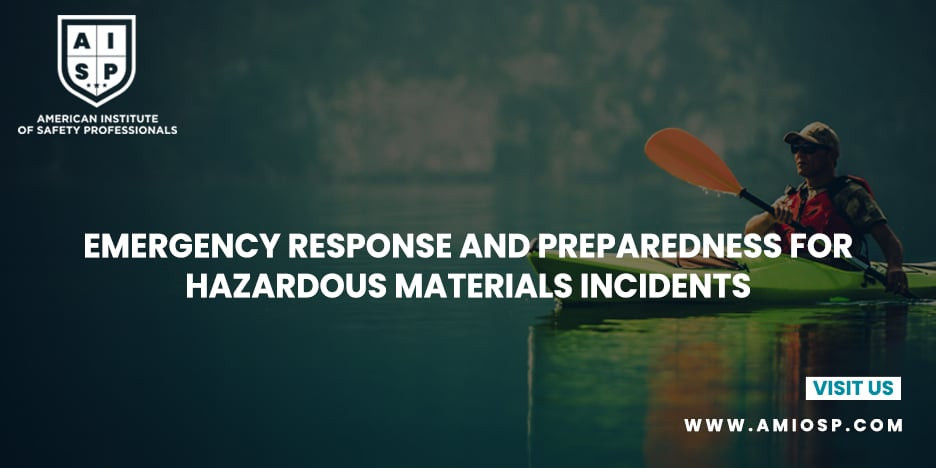Hazardous materials incidents pose significant risks to both
human health and the environment. Whether it's a chemical spill, a release of
toxic gases, or a fire involving hazardous materials, a prompt and effective
emergency response is essential to mitigate the impact and protect lives. In
this blog post, we will discuss the importance of emergency response and
preparedness for hazardous materials incidents, along with key strategies and
best practices to ensure a swift and efficient response.
1. Understanding the Risks:
To effectively respond to hazardous materials incidents, it
is crucial to have a thorough understanding of the risks associated with
different materials. Hazardous materials can have various properties, such as
flammability, toxicity, corrosiveness, and reactivity. Familiarize yourself
with the potential hazards posed by different materials, their chemical
properties, and their effects on human health and the environment. This
knowledge will help responders assess the situation accurately and implement
appropriate control measures.
2. Develop an Emergency Response Plan:
A well-designed emergency response plan is the cornerstone
of effective incident management. The plan should outline roles and
responsibilities, communication protocols, evacuation procedures, and specific
actions to be taken in different scenarios. Consider the following key
components when developing an emergency response plan:
a) Incident Command System (ICS): Implement the ICS
framework, which provides a standardized organizational structure for managing
incidents. Designate an Incident Commander and define clear chains of command
and communication.
b) Communication: Establish a reliable communication system
that allows for seamless communication between responders, emergency services,
and relevant stakeholders. Include backup communication methods in case primary
systems fail.
c) Evacuation Procedures: Develop clear evacuation
procedures, including evacuation routes, assembly points, and methods for
accounting for personnel. Ensure that evacuation plans are regularly
communicated and rehearsed.
d) Personal Protective Equipment (PPE): Define the types of
PPE required for different hazardous materials incidents and ensure their
availability. Train responders on proper PPE usage and conduct regular
inspections to ensure equipment integrity.
e) Training and Drills: Regularly train personnel on
emergency response procedures, hazard recognition, and incident management.
Conduct drills and exercises to test the effectiveness of the emergency
response plan and identify areas for improvement.
3. Establish a Command Center:
During a hazardous materials incident, establishing a
command center is crucial for coordination, decision-making, and information
management. The command center should be equipped with communication systems,
incident tracking tools, and access to real-time information. It should serve
as a central hub where incident commanders and support staff can gather to
assess the situation, make critical decisions, and allocate resources
effectively.
4. Assess the Situation:
Upon arrival at the scene of a hazardous materials incident,
responders must quickly assess the situation to determine the nature and extent
of the hazard. Conduct a thorough evaluation of the following:
a) Hazards and Risks: Identify the hazardous materials
involved, their quantities, and their potential risks to human health and the
environment. Consider factors such as toxicity, flammability, and
explosiveness.
b) Containment: Assess the integrity of containers or
equipment involved in the incident. Identify any leaks, spills, or releases and
take immediate measures to contain and minimize the spread of the hazardous
materials.
c) Safety Zones: Establish appropriate safety zones to
protect responders and the public from potential exposure. These zones should
be determined based on the nature of the hazard, wind direction, and potential
impact areas.
d) Resources: Evaluate the availability of resources
required for the response, such as personnel, equipment, specialized teams, and
materials for containment and cleanup.
5. Implement Control Measures:
Based on the assessment of the situation, implement
appropriate control measures to mitigate the hazards and protect responders,
the public, and the environment. Consider the following measures:
a) Personal Protective Equipment (PPE): Ensure that all
responders are equipped with the appropriate PPE for the specific hazards
involved. This may include protective clothing, respiratory protection, eye
protection, and gloves.
b) Containment and Spill Control: Take immediate actions to
prevent the further release or spread of hazardous materials. This may involve
deploying containment booms, using absorbent materials, or sealing leaks or
breaches.
c) Ventilation and Air Monitoring: Establish proper
ventilation systems to control the spread of toxic gases or fumes. Continuously
monitor the air quality to ensure the safety of responders and nearby populations.
d) Decontamination: Establish decontamination procedures for
both responders and potentially affected individuals. This includes providing
appropriate facilities and equipment for decontamination, such as showers and
decontamination solutions.
6. Coordinate with External Agencies:
Hazardous materials incidents often require coordination
with external agencies, such as fire departments, hazardous materials teams,
environmental agencies, and healthcare providers. Establish effective
communication channels with these agencies and include their contact
information in the emergency response plan. Collaborate closely with them to
leverage their expertise, resources, and specialized equipment.
7. Post-Incident Evaluation:
After the incident has been successfully resolved, conduct a
post-incident evaluation to identify lessons learned and areas for improvement.
Analyze the effectiveness of the emergency response plan, communication
systems, and coordination efforts. Use this feedback to update and enhance the
plan and provide additional training to responders based on the identified gaps
or weaknesses.
Conclusion:
Emergency response and preparedness for hazardous materials
incidents are critical to protect lives, the environment, and property. By
developing a comprehensive emergency response plan, establishing a command
center, conducting thorough assessments, implementing appropriate control
measures, and coordinating with external agencies, responders can effectively
manage hazardous materials incidents. Continuous training, drills, and
post-incident evaluations are essential for maintaining preparedness and
improving response capabilities. Remember, a well-prepared and efficient
response can make all the difference in minimizing the impact of hazardous materials
incidents.












0 comments
No Comments